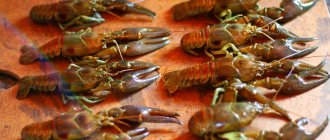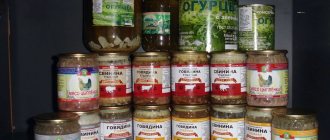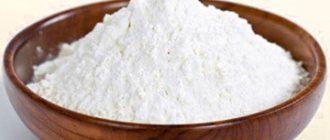Seafood poisoning is one of the most severe types. We are waiting for the opportunity to enjoy the delicacies. Only instead of pleasure we end up in a hospital bed. To prevent this from happening, it is important to consume only fresh, high-quality products with a normal shelf life.
We'll tell you how long shrimp can be stored in the freezer, refrigerator, or at room conditions. At the same time, we will select suitable packaging and adjust the temperature regime. The first bells are signs of damage.
Frozen fruit
Fruits contain water/juice, so when defrosted, a natural loss of moisture occurs and their texture changes accordingly - they become softer. Therefore, it is best to plan in what form you will use fruits in preparing dishes, sauces, jams and fillings for pies. Frozen fruit is also ideal for smoothies, sorbets and ice cream.
Shelf life of frozen fruits
Fruit can be stored in the freezer for four months to a year. If you plan to use the fruit in a mixed form, it's best to puree them before freezing - not only will this make them easier to incorporate into the recipe, but it will also take up less space in the freezer.
| Frozen fruit | Shelf life in the freezer |
| Apples | 4 months |
| Apricots | 6 months |
| Bananas | 8 months |
| Cherries | 6 months |
| Cranberry | 1 year |
| Peaches | 4 months |
| Fruit juices | 1 year |
How to tell if shrimp have gone bad
Typically, product quality is determined by organoleptic indicators. We do not recommend tasting it. There are many other ways to determine spoilage. The simplest one is to smell it. Most people do this. Open the package and immediately inhale. Fresh, high-quality shrimp smells of the sea, vaguely of algae, and fish. The missing analogue has an ammonia smell.
An indirect sign of spoilage is an abundance of ice in the package. The shrimp thawed, released water, then froze again. Sometimes manufacturers specifically make ice crusts to increase weight. We also avoid this product. For high-quality freezing, excess moisture is removed from the broth. The exception is targeted glazing.
Shrimp can be not only extremely healthy, but also harmful to health. They don't last long. We purchase imported chilled seafood with caution. We try to purchase frozen food in bags with a transparent window. It is more convenient to look at and smell crustaceans. Just a question: how long have they been stored in a warehouse or store freezer?
Source
Additional tips and tricks
If you plan to eat the product in the coming days, then it is permissible to buy it for any period of time. First study the expiration dates indicated on the packaging. For long-term storage, it is better to choose a product in sealed packaging.
To prevent the cut of the stick from drying out, it is treated with egg yolk or lemon juice. If the stick has dried out over time and become hard, it is recommended to hold it over steam for 16 minutes. After this, they are put into the refrigerator compartment. To quickly remove the casing from the sausage, place the stick under cold water. If you follow all the recommendations and rules for storing sausage products, you will be able to preserve the taste and quality of the raw materials for a long time.
Share link:
In a saucepan
Before cooking, make sure that the seafood is raw and not cooked. Thaw frozen shrimp so that they do not stick together or turn into mush. Do this in the refrigerator rather than at room temperature. Place fresh chilled seafood into boiling water without preparation.
Cooking unpeeled raw shrimp on the stove:
- Pour 2 liters of water into the pan, bring to a boil, add 1–1.5 tbsp. l. salt, 1 cut lemon or lime.
- Place 1 kg of shelled shrimp in boiling water.
- Cook the crustaceans until done. Their shells should turn pink.
- When cooking is complete, turn off the stove, place the shrimp in a colander, and let the liquid drain.
- Place seafood on a plate and sprinkle with freshly squeezed lemon juice. To prevent the shrimp from becoming tough, do not leave them in the broth.
Cooking raw peeled shrimp:
- Place 1 kg of prepared seafood without shell into a saucepan and fill with cold water.
- Add salt and lemon, cut into 4 parts.
- Place the container on the stove.
- After boiling, cook the shrimp over low heat.
- Remove the finished product from the liquid with a slotted spoon and place on a plate to cool.
Another popular way of preparing shrimp is with bay leaf and dill:
- Place 500 g of seafood in a saucepan with boiling water.
- After boiling, add 1 tbsp. l. salt, 3-4 bay leaves and a bunch of dill fastened with threads.
- Cover the container with a lid and wait 2-3 minutes.
- Turn off the stove, drain the water, remove the dill and laurel.
- Serve the shrimp with a squeeze of lemon and a squeeze of juice.
Criteria for choosing fresh fish
Not only its appearance and consistency are important, but also its smell. In the store, fresh fish carcasses should be on ice.
Appearance
What to look for when choosing a product:
- fresh fish does not bend, but elastically retains its straight shape;
- its scales are moist, shiny, undamaged, and adhere firmly to the skin;
- the eyes are clean, transparent, without a veil, not sunken;
- if large carcasses are sold in parts, they should not be reddened from blood residues and, especially, bruises.
Gills
For most popular types of fish, they should be red; for stale products, they should be gray, white, light brown, and the mouth should be closed.
Smell
The fresh product does not emit an unpleasant odor. A strong characteristic “aroma” is evidence of improper temperature conditions during transportation or storage.
Features of storage in the refrigerator compartment
The average temperature maintained in the refrigerator is from 0 to +4-6 degrees. The coldest place is on the top shelf, under the freezer, where it is recommended to store meat dishes.
Fresh
At temperatures from 0 to -3 degrees, meat can lie for 2 days in enamel dishes or paper. If there is no other container, you can put it in a plastic container. Tenderloin, chops, and ribs are placed on a separate shelf to protect them from foreign odors.
Boiled
Boiled pork, beef, and poultry will last longer in the broth and in the pan in which it was boiled. Shelf life: no more than 2 days.
Smoked
The shelf life of cold smoked products is 3 weeks, hot smoked products are up to 7 days. Smoked meats are wrapped in foil and parchment. After opening the original packaging, it is better to transfer them to a paper bag or foil and store them in the freezer for no longer than 3 days.
Thawed
Once defrosted, food should not be put back into the freezer. The flesh should gradually thaw in the refrigerator or at room temperature so that the chops or goulash are soft and juicy.
It is better to marinate the leftovers and cook the next day.
Dried
Thin strips of beef are stored in zip-lock bags in a glass jar lined with paper napkins on the inside. Beef jerky will keep for 3 months in the refrigerator. The napkins in the jar need to be changed every 3 days. Also, for storage, the pieces are rubbed with vegetable oil and wrapped in cloth.
Stew
Opened canned stews can be stored for no more than 1-2 days. The pan with meat stewed according to a home recipe should be emptied 3 days in advance.
Roast
Store the roast in an airtight container in foil on the top shelf in the refrigerator. The finished dish can be transferred to a ceramic dish with a tight lid. It is better to reheat once, since alternating heat and cold destroys the beneficial substances in the product.
Chilled
Storing beef and pork:
- from 0 to +2 degrees - 2 days;
- up to -2 degrees—12-16 days;
- -3 degrees - 20 days.
Chicken is stored at 0 degrees for up to 15 days, and at -2 degrees below zero for 4 days.
How to properly cook king prawns
Shrimp as a stand-alone dish is usually cooked with various spices, seasonings and sauces - such as lemon juice, soy sauce or garlic
But here it is very important not to overdo it - additives should only slightly emphasize the taste of the natural product, and not interrupt it
Shrimp can be prepared in several ways:
1st method
The first method is only suitable for boiled frozen products and consists of simple defrosting without further heat treatment. To do this, place the product in a colander and pour boiling water over it. The shrimp will thaw quickly, and the water will wash away all the dirt from them. You can simply leave the shrimp at room temperature and wait for them to defrost naturally. After this, the product is ready for use.
But this method has a drawback - since the shrimp are frozen without salt and spices, the finished product will turn out a little bland. Shrimp thawed in this way can be used for further frying in vegetable oil with garlic or used for salad. They can also be baked or grilled with spices.
2nd method
The second method is suitable for absolutely all types of shrimp - frozen semi-finished and chilled.
- The product is thrown into a colander and doused with cold running water - in a few seconds the ice crust will melt and wash away the adhering dirt from the shrimp.
- Put water on the stove (there should be three times more water than shrimp), boil, add salt and spices - the juice of one lemon, salt, bay leaf and peppercorns.
- Place the shrimp in boiling water and cook for 3-10 minutes, depending on the type.
- After 3-10 minutes, remove the saucepan from the heat and leave the shrimp to simmer in the broth for another 10 minutes - this will make them juicier.
- Place the boiled product in a colander again, let it cool and enjoy the aromatic boiled shrimp.
Boiled frozen shrimp are cooked for about 3 minutes, fresh frozen – 7-10 minutes. Cooking time for large king and tiger prawns increases by 5-10 minutes. If the shrimp have floated to the surface and their shell has become slightly transparent, the product is ready
It is important not to overcook the shrimp - overcooked meat becomes tough and tasteless
Ready shrimp can be seasoned with olive oil and the juice of half a lemon, or served with curry or adjika.
3rd method
Shrimp can be cooked not only on the stove, but also in the microwave - they will turn out boiled in their own juice. The shrimp are placed in a container with a small amount of water, salted, peppered and placed in the oven for one minute.
A steamer is also great for cooking shrimp. Just 4-5 minutes is enough, and the finished dish will turn out very tender. A double boiler allows you to preserve maximum beneficial properties.
If you have a multicooker at home, you can use that too. Frozen shrimp are placed in a slow cooker, salted, sprinkled with lemon juice or lemon slices are placed on top of the meat, and the “baking” mode is turned on for 10-15 minutes. No need to add water.
4th method
Shrimp can be stewed in sauce. This method is equally good for boiled and uncooked semi-finished products.
Top articles: How long can frozen mushrooms be stored in the freezer
The cooking process will be as follows:
- Pour a small amount of vegetable or olive oil into the bottom of a tall frying pan or saucepan.
- Add a few cloves of garlic and half an onion to the oil.
- Place half a kilogram of frozen shrimp in the oil and pour in half a glass of water.
- Bring the shrimp to a boil with the lid closed and cook for 3-5 minutes.
Shrimp shelf life
The period for which shrimp can be stored in the refrigerator will depend on both the type of product and the conditions of storage.
The longest storage time is for shrimp frozen alive. Ready-to-eat, for example, fried shrimp have a significantly shorter shelf life even when stored in the freezer.
When storing shrimp in a common refrigerator compartment, the following requirements must be met:
- the temperature in the common chamber should be from 4° to 6°C;
- The shelf life of shrimp cannot exceed 3 days.
To ensure longer storage of shrimp, you will need to place them in the freezer.
The conditions and shelf life of shrimp in the freezer can be represented as follows:
- the temperature in the freezer should be about -20°C;
- The shelf life of shrimp in the freezer can be up to 4 months.
Separately, you can consider storing shrimp with ice. In this case, they are placed in a colander, layered with sea grass and finely crushed ice. Place a colander in the pan so that the draining liquid does not accumulate in the shrimp. Shrimp cooled in this way can remain suitable for consumption for up to three days, at a temperature of about 0°C - up to five days.
It is worth knowing that shrimp spoil very quickly at room temperature. From the moment of defrosting, shrimp remain edible for literally several hours. Therefore, in order to prevent food poisoning, thawed shrimp cannot be re-frozen.
How to Preserve Boiled Shrimp
Intoxication is caused not only by expired products, but also by the reagents with which they are treated to improve their presentation. You should not purchase ready-made shrimp with a shelf life of more than 90-120 days, even if they are beautiful and bright. It is unknown what they were soaked in during pre-sale preparation.
Products in the marinade should be eaten within 24 hours. Even if they look fresh, the process of decomposition has already begun in the tissues. Aromatic seasonings will make it difficult to determine by taste whether the crustaceans have begun to spoil.
How to properly store in the heat and on the road
Some tips will help extend the freshness of the product while traveling:
- The stick is pre-dried and then wrapped in paper.
- It is not advisable to stock up on boiled or liver sausage on the road.
- Do not put sausages in a plastic bag.
- The best option would be to cut it in an airtight container.
Finished sausage products do not tolerate hot conditions well:
- If there is a cut, it is treated with egg yolk, and the product itself is packaged in foil.
- Garlic or mustard powder placed inside the foil will help preserve the quality of meat products.
- A cloth soaked in vinegar solution, in which the sausage is rolled, helps save the product from the heat.
Chilled
Not only storage temperature affects the shelf life of shrimp, but also the type of packaging.
- The weighed product is wrapped in wax paper or foil. You cannot keep crustaceans in a plastic bag: they will quickly deteriorate.
- Storing boiled shrimp in the refrigerator is almost the same as storing a fresh-frozen product. They differ only in the duration. You can keep boiled crustaceans on the refrigerator shelf for no more than 3 days.
- Crustaceans have a specific smell. Therefore, they are kept in the refrigerator separately from other foods so that they do not absorb it.
- To store this product, it is better to choose a cooler place in the refrigerator.
You can store shrimp in the refrigerator for a maximum of 5 days.
Prawn selection
It's no secret that shrimp should be chosen correctly. After all, a bad product can lead to serious consequences - food poisoning. Therefore, a healthy dietary product can turn out to be quite dangerous. Let's look at the basic rules for choosing shrimp:
- Availability of ice. There should not be a lot of it, the percentage of glaze should not exceed 7%. If there is a lot of ice, this means that the shrimp were stored incorrectly or were defrosted during transportation, and were subsequently re-frozen. If the product is packaged, make sure there is not a lot of snow or pieces of ice.
- Feel free to smell the seafood. If shrimp are taken by weight, then you can evaluate the crustaceans by smell. Fresh shrimp smell like the sea, and a sharp and unpleasant odor indicates that the product is stale.
- Tail position. If the tail part of the crustacean is straightened and not tucked towards the belly, this means that they died before heat treatment. You should immediately discard such a product.
- If there are black spots on the body of a seafood product, such a product cannot be taken, much less cooked. This means that the crustacean was seriously ill in life.
- The presence of a serious illness of the crustacean is also indicated by the black color of the head; such shrimp cannot be taken. Moreover, if the head is brown or green, then the crustacean has healthy and tasty meat.
- The eyes of shrimp should not be cloudy (normal color is black).
- The color of the product should be pink; if the body of the shrimp has acquired a yellow tint, this indicates that it is not a completely fresh product.
- If you buy fresh, chilled shrimp, the limbs and whiskers should be kept in place, and the shell should remain strong. Good fresh shrimp is always moist, not dry.
How long can shrimp be stored?
Whether seafood is of high quality or not can be determined by its appearance. Properly frozen shrimp have a uniform color and a slightly bent tail. To evaluate the appearance of crustaceans, it is better to choose transparent packaging that is free of snow and ice. You should carefully read what is written on the label. In addition to the expiration date, a self-respecting manufacturer indicates its details - address and telephone number. If the product is of poor quality, you should not count on long-term storage. However, it is not worth purchasing, much less cooking.
How to choose the right one
If the chicken is in a package, then the date must be indicated on it. If it is missing, it is better to open the package to check the quality of the product. When buying a chicken at the market, be sure to smell it in the area of the incision on the stomach. Fresh meat has virtually no odor. The carcass should not smell of bleach or vinegar. These smells confirm that the bird has been lying there for a couple of days and they tried to “reanimate” it.
It is also worth paying attention to the condition of the skin. If the chicken was sold without packaging, it should be a little dry
Its normal color is white. Fat birds and those fed corn have a slightly yellowish tint.
If you press on fresh chicken flesh, it will quickly return to its shape. The poultry meat should be pinkish and the fat should be light yellow. You should not purchase a product that is sitting in a puddle of pink liquid. This indicates that the bird was soaked for a long time to give it extra weight. If the bird is frozen, there should be no pieces of ice on it. An ice crust indicates multiple freezing.
If you plan to freeze the bird for several months, it is recommended to take it chilled. Its advantage is that, without even leaving the counter, you can determine the freshness of the product. And it will be much easier to prepare a chilled bird by dividing it into parts.
How to tell if seafood has gone bad
You should not try shrimp before purchasing. The taste of freshly frozen or boiled in this way is almost impossible to determine - solid ice. You should be guided by smell and appearance. Signs of damage:
One of the signs of loss of presentation is a blackened head. But the green head of freshly frozen or chilled shrimp indicates quality and naturalness. In their natural habitat, crustaceans feed on plankton, so this color is natural.
Yellowish stripes and pigment spots on chilled crustaceans are not signs of spoilage. But it is not recommended to buy them. This is a sign of age, and the meat of adult shrimp is tasteless - tough or flabby.
How to prepare fish for storage in the freezer?
Only fresh product that has been previously cleaned, gutted and washed can be frozen. Before placing the fish in the freezer, it is recommended to store it in the refrigerator, preferably on a bed of ice. Be sure to get rid of the scales on the carcass and gut it. And there are several reasons for this:
- firstly, after defrosting, the fish will become softer and it will be more difficult to clean it;
- secondly, the insides contribute to the rancidity of tissues, which negatively affects the taste of the prepared dish;
- thirdly, it is recommended to immediately divide fresh fish into fillets and steaks, and then freeze them in portions.
The manipulations listed above will save time on cutting the carcass and wisely use the space in the freezer.
Basic rules for storing raw shrimp
Crustaceans are one of the most capricious types of seafood. At room temperature, they will spoil within a few hours after defrosting. To prevent this from happening, they are defrosted on a shelf in the refrigerator.
If you purchased shrimp in vacuum or paper packaging, open them only before cooking. When purchasing “by weight” in plastic bags, they must be placed in a container with parchment or foil placed at the bottom.
How to store in the refrigerator
Crustaceans stay fresh on the coldest shelf for 2 days.
There are a few secrets to keeping them juicy:
You can’t leave shrimp uncovered, and not only because all other food will also smell like the sea. They may dry out. To prevent this from happening, place cotton cloth or gauze folded in several layers on top, under the lid.
Shelf life of prepared meals
They vary depending on the technology of preparing the product - frying, boiling, salting, smoking.
Boiled, baked, fried
Heat-treated raw materials can be stored at room temperature for up to 3 hours. Then the dishes are placed in the refrigerator for up to 2 days at a temperature of 3-6 °C.
Smoked
If the following conditions are met, the hot smoked product can be stored fresh for up to 3 days:
- at temperatures from -2 to +2 °C;
- humidity – 75-80%;
- constant supply of fresh air.
When frozen, it retains its consumer properties for up to a month while maintaining a temperature of about -30 °C and humidity of 90%.
The permissible storage time in the freezer depends on the type of raw material:
- mackerel, herring, and other species can be stored for 1.5-2 months;
- fish balyks, cold smoked fillets – 15-30 days.
Sun-dried, dried
To prepare this product, a large amount of salt is used - a natural preservative. Cured and dried carcasses can be left wrapped in parchment or white paper in a cool, dry, dark place for up to a year.
Salty
The shelf life of salted fish is affected by the degree of salting and fat content of the raw materials:
- Lightly salted salmon can be stored in brine for 3 days;
- salted product in vacuum packaging – 30 days;
- lightly salted herring – 7 days;
- herring in medium and strong brine – 14-30 days;
- fatty varieties of salted mackerel – 10 days.
The place where salted fish is stored in brine outside the refrigerator is dark, dry, at a temperature of 10-12 °C. The salted product is stored in the refrigerator for up to 10 days.
Storage without refrigeration
At room temperature, fresh shrimp can spoil very quickly, in just a few hours.
But if there is a need to keep them without refrigeration, it is better to place the crustaceans in salt water. This will extend their freshness for another 2-3 hours.
To keep already chilled shrimp warm for as long as possible, they are wrapped in several layers of foil and put in the coolest place in the apartment, which is closed from sunlight.
Boiled shrimp are stored at room temperature for 2 – 4 hours. On average, these crustaceans will remain fresh for up to 5 hours without refrigeration.
What factors affect shelf life?
Shelf life is influenced by such factors.
Feedstock
A premium product contains at least 62% muscle tissue. Such meat is not frozen, so the product is less susceptible to pathogenic microflora. The shelf life of such products is long. Sausages of the first and second grade have less than 58% muscle tissue.
Production technology
Most types of sausages are first boiled and then smoked. Cooking time depends on the thickness of the stick. Then the product is additionally dried for 3 days. The shelf life of smoked products is much longer.
Type of shell
The shell is used to maintain the shape of the product and protect against the penetration of various bacteria and dirt. When purchasing, you need to carefully inspect the packaging. There should be no signs of deformation or damage.
Natural
The main advantage of such a shell is that it is allowed to be eaten. But along with this advantage, there are also disadvantages:
- it takes longer to manufacture the product;
- such a shell is difficult to peel off;
- storage periods are minimal.
Semi-synthetic materials
The shell is made of semi-synthetic material and does not allow air to pass through and does not allow the penetration of external unfavorable factors. If all conditions are met, the product can be stored for up to two weeks.
Vacuum packed
The result of improving sausage production technology was the creation of vacuum packaging. It allows you to preserve the taste, smell and freshness of the product much longer (up to 4 weeks).
How long can shrimp be stored and how to store the product correctly
Seafood is a healthy and tasty addition to your diet. For the last 10 years, they have not been considered exotic - they are served in cafes and restaurants, in the form of cocktails, and added to salads, soups or hot dishes. Frozen shrimp can be easily purchased at the supermarket and prepared at home. But it is very important to understand that these products can only be consumed fresh. Therefore, you need to pay attention not only to the expiration date indicated on the packaging, but also to the appearance. An unscrupulous seller may offer a low-quality product, and intoxication with seafood is just as dangerous as with mushrooms.
Optimal conditions
Raw fish cannot be kept in a refrigerator at above-zero temperatures, as this product is subject to rapid spoilage due to the development of bacteria and moldy fungi. They begin to multiply within a couple of hours after the temperature rises and lead to rotting.
https://youtube.com/watch?v=pxd5nZTCGrk
Fish, if properly prepared, has a shelf life in the refrigerator of 1-3 days. At the same time, raw minced meat, cutlets or fish pieces can be stored for only 10 hours, and fillets for 24 hours. In the freezer, where the temperature reaches -24°C, fish can last from 3 to 6 months, depending on the fat content.
The main storage conditions are vacuum packaging (extends the shelf life of fish to 4-5 days) and temperature conditions. Cold destroys microflora and slows down the fermentation process.
Temperature
The ideal storage temperature is from -2°C to 0°C. With this mode, the fish will be preserved for three days. Unfortunately, most often the temperature in refrigerators is 5-6°C, so the period is reduced to just one day.
If the gif does not start, click
If there is no temperature-controlled zone in the refrigerator, you can make one yourself using a container with ice and store the fish there. With this method, you need to constantly monitor the condition of the ice so that it does not melt. If this suddenly happens and the carcasses end up in water, they will spoil very quickly.
Storage periods and rules
Animal and poultry meat is stored at temperatures from 0 to -3 degrees for 2 days, and at -3...-5 degrees for up to 4 days.
Pork
At +7 degrees, the shelf life of pork is less than 24 hours, at -3-0 degrees - up to 2 days. Pork tenderloin and parts of the carcass are wrapped in foil for freezing. They are stored in a plastic bag with holes on the bottom shelf of the refrigerator.
Beef
The shelf life at temperatures from 0 to +7 degrees in the refrigerator is 7 days, at -18 - up to six months. Beef tenderloin and steak are wrapped in parchment.
Mutton
Freshness is preserved for 2 weeks at temperatures down to -15 and 90% humidity. Freezing at -18 degrees will preserve meat for 10 months. Shelf life at -5 degrees is 3 days. The cooled product is stored in a container with ice, under a damp cloth, using foil and thick polyethylene.
Chicken
Chilled chicken is stored for 5 days at +2 degrees; at 5 degrees, chicken sits for 12 hours. At zero temperature the product is suitable for consumption within 14 days. Frozen chicken is stored for 4 months at -12 degrees, 8 months at -18. Poultry meat can be stored at -25 degrees throughout the year. Chicken meat is stored in plastic containers and plastic bags.
Goose
The goose carcass is wrapped in foil or parchment to protect it from foreign odors and stored at 0 degrees for 2 weeks. Chilled goose meat is stored at +2 degrees for 3 days. Freezing will extend the shelf life to 7 months.
Duck
Frozen poultry is stored for six months, at 0...+4 degrees - 3 days. The meat is stored in an enamel container, under a lid. Wings, drumsticks, and fillet parts can be placed separately in a glass bowl or wrapped in foil. Polyethylene is only suitable for freezing.
Rabbit
Rabbit meat is stored for 5 days at temperatures from 0 to +4 degrees. Before freezing, a fresh carcass is hung and kept for 8 hours at +5 degrees. Then the rabbit is cut up or packed whole in a plastic bag. At -18, rabbit meat will last for six months.
Turkey
A plastic bag or cling film is suitable for freezing. The whole carcass is stored for a year, and parts - 9 months. Temperature conditions and storage periods:
- -14 degrees - a week;
- -4 degrees - 4 days;
- -2 degrees - 2 days.
For refrigerated storage, you need to separate the bones, since the meat around the bones spoils first. Turkey giblets should also be stored separately, as an ungutted carcass will spoil faster.
Ground meat
The product is stored:
- at +4-8 degrees - 12 hours.
- -18 - 3 months;
- -12 - 30 days.
Chilled minced meat will spoil at room temperature in 2 hours. Therefore, it must be cooked immediately or frozen. Large volumes of minced meat are placed in enamel containers, portions are wrapped in polyethylene.
By-products
Liver frozen in blocks is stored for 4-6 days, and individually - 2-4 days at a temperature of -12-18 degrees. At a temperature of 0 to 2 degrees and a humidity of 85%, liver is stored for 36 hours, at +8 degrees for a day. The giblets are wrapped in polyethylene.
Tips for storing in the refrigerator
In order for the dish to remain fresh, you need to know how to store sushi in the refrigerator. The basic rules are quite simple.
- If you are preparing a dish at home, choose only fresh ingredients for it, and buy lightly salted or smoked fish, but it is advisable to avoid frozen fish, because it is not known how long it lay in the refrigerator before the buyer found it.
- Most rolls are prepared and served cold, but there is a type that is served hot; they cannot be stored and must be eaten immediately after cooking, otherwise they will lose their taste.
- If you order Asian food at home, it is delivered in plastic boxes. The delicacy cannot be stored in such boxes, because the rice may become weathered and the dish will lose its taste.
- If after a meal you have a few rolls left, they must be carefully placed on a plate and wrapped in cling film: it will prevent the rice from chapping and extend the shelf life of the dish.
- When you order a product at home, check the tray in front of the courier and determine whether the product was brought to you fresh. If the rolls are fresh, the rice will be white and the filling will not be dry (it is very easy to visually distinguish fresh rolls from stale ones, just look at their appearance).
- If you bought packaged sushi in a supermarket and do not want to eat it right away, check the expiration date of the product and open the tray immediately before eating it.
- The product should only be kept in a cool place.
These tips will help preserve the taste of Japanese delicacies throughout their shelf life.
Do not store this dish for a long time (no more than a day), because it contains seafood and, if spoiled, can lead to serious poisoning of the body.
27 Jul 2022 edypravilno 1047
Methods for harvesting blueberries for the winter
In order to preserve the beneficial properties of blueberries as much as possible, it is recommended not to heat treat the berries, not to chop them, or even wash them.
Before harvesting, blueberries are carefully sorted, getting rid of rotten and spoiled berries, leaves and other plant debris.
Freezing
The fastest and easiest way to prepare can be called freezing. If you picked the blueberries yourself in an environmentally friendly place, then you can do without washing. It is better to rinse berries purchased at the market with running water, removing all debris, and then dry thoroughly, spreading them in one layer on a towel.
For freezing, take small containers or plastic bags, into which it is convenient to place the berries in portions so that you can then defrost them in the required quantity. After thawing, blueberries remain tasty and practically do not “float”, that is, they retain their shape, texture, color and aroma.
Frozen berries are used to prepare a variety of desserts, baked goods, compotes and other dishes.
Drying
Another traditional harvesting method that allows you to preserve the usefulness of berries is drying. Before drying, the collected ripe fruits are examined and cleaned of debris without washing or soaking.
At home, the easiest way to dry blueberries is in a special dryer or oven, especially if there is convection. The berries are laid out in one layer on a baking sheet and first dried for 2-3 days in the air in a well-ventilated area or 2-3 hours in the oven at a temperature of 35-40 ℃, and then dried at 50-60 ℃. Drying time takes quite a lot - 6-12 hours, depending on the size and juiciness of the berries. The oven door should be kept slightly ajar or constantly opened and wiped off any condensation that accumulates. Dried berries, if squeezed in the palm of your hand, should not stick together into a lump and stain the skin of your hands.
Well-dried blueberries can be stored in moisture-proof containers under normal home conditions (in a dark, cool place) for up to 2 years.
As one of the drying options, you can prepare blueberries with sugar for the winter without cooking in the form of marshmallows.
Blueberry marshmallow
Many housewives prefer not to dry the whole berries, but to prepare a natural delicacy from them - marshmallows. Blueberries are often mixed with various fruits (apples, pears, apricots) or with vegetables that have a neutral taste, such as zucchini. In this case, the composition of the marshmallow, the proportions of ingredients, and the need to add sugar are determined individually.
Ingredients:
- fresh blueberries – 1 kg;
- sugar – 1-2 tbsp. l. (taste).
Cooking technology:
- Grind whole, clean, dry berries (and other fruit and vegetable ingredients) into a homogeneous mass - puree in a blender, grind through a meat grinder or steam and press through a sieve. Sugar to taste.
- Spread the resulting puree on a baking sheet covered with parchment in a thin layer (3-4 mm) for even drying.
- Dry in the oven at low temperature (+45...50 ℃) for 4-6 hours or in a well-ventilated warm room for 4-5 days.
- Cut the finished marshmallow into strips and roll into rolls. Place in a dry container, close the lid tightly and store in a cool, dark place.
Properly dried marshmallow stops sticking to your hands and is easily removed from the parchment, remaining quite elastic and unbreakable when folded.
An experienced housewife talks about various methods of preparing blueberries, including making marshmallows, in the following video:
How to prepare shrimp for storage
You can freeze shrimp at home. Boiling is allowed in any convenient way. An important point - do not overexpose. Average cooking time is 3-4 minutes. For freezing, boil no more than two. Shrimp are best stored in a starch glaze. We offer a proven recipe.
Cooking instructions:
- Lightly add boiling water. If desired, add pepper, dill, and any seasonings.
- Add the shrimp, cook for 2 minutes, and place in a colander. You can douse it with ice water.
- Mix a liter of water with a spoon of starch, prepare jelly, cool. We recommend doing it in advance.
- Pour the starch glaze over the shrimp, let the droplets drip off, and place on film. We put it in the freezer.
- We are waiting for it to harden. It will take approximately 2-3 hours. Pack it up and return it to the freezer.
We do not recommend freezing fried crustaceans. They taste better when freshly prepared. For frying in a pan or grilling, it is customary to save raw shrimp. It’s good if the freezer has a fast No Frost function.
Freezing and Cooking Boiled Shrimp
Fresh fish: how to select and store
When purchasing fresh fish, it is recommended to cook it the same day. If this is not possible, then storing the product without freezing is permissible for no more than 24 hours in the refrigerator, provided that the product is of high quality. To extend the shelf life to 3 days, you can collect ice in a plastic container, place the food in it, tightly cover it with a lid, and put it in the refrigerator.
It is important to understand that shelf life also depends on whether you are able to purchase fresh fish in the first place. For example, when the fat turns yellow, this is a sign that the fish may spoil in the near future.
If it was in your refrigerator and turned yellow, this is acceptable for some species (for example, second-class herring), but it means that you need to cook and eat it urgently (in the absence of other signs of spoilage) or throw it away immediately.
It is not recommended to store fish that has not been gutted or cleaned for a long time.
Rice. 1 — Preparing fish for storage
How to store fresh fish in the refrigerator:
- First gut it and clean it of gills and scales, cut off the head.
- Rinse the carcass on both sides and remove the liquid by blotting with paper towels.
- The refrigerator must be set to the correct temperature. The optimal temperature is considered to be from -3 to 0, at which the fish is stored for 2 days. In ordinary refrigerators, the product will remain usable throughout the day, that is, it must be prepared within 24 hours from the date of purchase.
- Store in a closed container to prevent other foods from becoming saturated with fishy odors. Plastic bags are not suitable for this.
How long can shrimp last in the freezer? I wanted to cook it, but I think they’ve been lying around for a long time.
The shrimp is a small sea crustacean, Pandalus borealis, that lives in almost all seas of the world. Shrimp vary greatly in size: the largest are less than 20 pieces per 1 kg, and the smallest in the same kilogram can be from 100 pieces or more.
The most popular among chefs are large (and quite expensive) tiger shrimp with characteristic stripes on the shell, which are grown on farms in the Mediterranean, Malaysia, Taiwan and other countries of Southeast Asia. However, there is an even larger jumbo shrimp - up to 30 centimeters long. Small European shrimp, which are found in the Norwegian fjords and the Skaggerak Strait, are also highly prized.
The numbers you see on the packaging of shrimp are the quantity per kilogram. The most common medium shrimp in the world are labeled 90/120 (from 90 to 120 pieces per kilogram). 50/70 are very large, selected shrimp, 70/90 are large, 90+ are the smallest.
If we consider that the shelf life of processed and chilled shrimp does not exceed four days, it is clear why they often reach us frozen, and the vast majority are already boiled immediately after being caught directly on a trawler in sea water. All that remains is to slowly defrost them and heat them up for 1-2 minutes in boiling water or oil in a frying pan (and for salads, you don’t even need to heat them up).
The tail of a boiled-frozen shrimp should be bent - this is evidence that it was cooked alive immediately after catching. The more the shrimp is bent, the longer it has lain before cooking and the worse the quality. The black head also indicates poor quality - this means that after catching the shrimp was not frozen for a long time.
The meat of these crustaceans is a real natural storehouse of all sorts of useful things. There is especially a lot of iodine in it, it is rich in sodium, calcium, phosphorus... - you can list almost half of the periodic table. It also contains a lot of protein, but practically no fat.
31 Oct 2022 edypravilno 239
How to extend the shelf life
Simple ways to help keep beef, pork and poultry fresh a little longer:
- To store in the refrigerator, cut into portions and place in glass containers;
- at the first sign of spoilage, wash the pieces in clean water and soak in a concentrated salt solution with the addition of a few drops of vinegar;
- put meat in or under the freezer, in the zone with the lowest temperature;
- marinate;
- remove bones, gut the bird;
- to freeze.
To keep meat at room temperature for 2 days, place it in a bowl of cold water. The workpiece can also be stored in the refrigerator if you fill it with milk and cover the container with a lid.
Selecting fish for frying
The realities of the modern world make it possible to choose fish for frying to suit every taste, taking into account material capabilities and taste preferences.
Top articles: Where to store homemade apple cider vinegar
You can fry any fish, but practice shows that a dish made from fatty, non-bony varieties will be more successful. The pieces will be juicy, golden brown, and a small number of small bones will make consuming the dish comfortable. Low-fat varieties will turn out dry, and when stored in the refrigerator they will completely lose their taste and become loose.
Both river and sea fish are suitable for cooking in a frying pan:
- Carp, catfish, river trout, bream, carp. They are quite fatty and have a relatively small number of small bones. River pike and bream are also suitable, the taste is amazing, but you will have to choose the bones longer.
- Cod, pollock, pelengas, and halibut are also great for frying. Sea fish has several advantages: it is tender and fatty, has a small number of small bones, and can be stored well in the refrigerator.
- Sterlet, beluga, sturgeon - such a dish will decorate any holiday table. Fried fish can become a real delicacy if you use the sturgeon family for cooking.
Requirements for containers
For freezing berry preparations, two types of containers are used:
- Plastic bags - it is advisable to purchase special freezing bags for these purposes. They have a dense structure and are therefore resistant to mechanical damage. They have a lock on the side for ease of use. It is not advisable to use this container for berries with a soft texture.
- Plastic containers - choose containers that are resistant to low temperatures. The container must have an airtight lid. The containers are convenient to stack on a shelf and do not take up much space.
For any type of container, it is recommended to purchase special stickers on which the date of packaging should be indicated. The shape is convenient to use rectangular plastic containers. Choose dishes with strong walls and a tight-fitting lid. It’s convenient to freeze the product in portions, so you don’t have to defrost the whole package.
Frozen poultry
Whether it's a whole bird or cut into pieces, making sure it's packaged well is the key to fresh poultry. The bird can be stored in the freezer for anywhere from four months to one year, depending on its shape.
Shelf life of frozen poultry
Two important things to remember when freezing chicken are to handle it properly when raw due to the risk of salmonella poisoning, and once the chicken has been thawed, do not refreeze it as this can increase bacterial growth.
| frozen bird | Shelf life in the freezer |
| Whole bird | 1 year |
| Raw pieces, with or without bones | 9 months |
| Cooked poultry, whole or pieces | 4 months |
| Giblets | 4 months |
How to properly boil different types of shrimp?
All shrimp need to be cooked according to approximately the same scenario, but it is important to remember some nuances. To always get the perfect result, you should follow these instructions:. King prawns
It is not so important which recipe is chosen, the main thing is how long the product is boiled. As a result, its color should become uniformly pink, closer to red. The optimal holding time is 8-10 minutes at constant boiling. If you overexpose the product even a little, it will become practically inedible. When everything is done correctly, the products do not break, are easy to clean, the meat is tender and juicy
King prawns
It is not so important which recipe is chosen, the main thing is how long the product is boiled. As a result, its color should become uniformly pink, closer to red.
The optimal holding time is 8-10 minutes at constant boiling. If you overexpose the product even a little, it will become practically inedible. When everything is done correctly, the products do not break, are easy to clean, and the meat is tender and juicy.
Tiger chrimp. To boil fresh products, it is best to use the classic recipe. Bring the water to a boil, add salt. Be sure to add a few peas of allspice and quartered cloves of garlic. Place well-washed shrimp in aromatic boiling water. You need to cook them again until the color changes. Depending on the size, the time can be from 5 to 10 minutes.
Black Sea shrimp. This product has a deep, special taste. It should be noted that Black Sea marine fauna will be spoiled if you overdo it with seasonings. The optimal approach is the following - raw products should be boiled in salted water with several peas of allspice until their color changes to red. Sometimes a bay leaf is added, but most often this turns out to be unnecessary.
But the most flavored seafood goes best with beer. When boiling shrimp as a snack for a foamy drink, you can use coriander, dill seeds, red pepper and much more. The products acquire a very unusual taste if you boil them directly in light beer.











